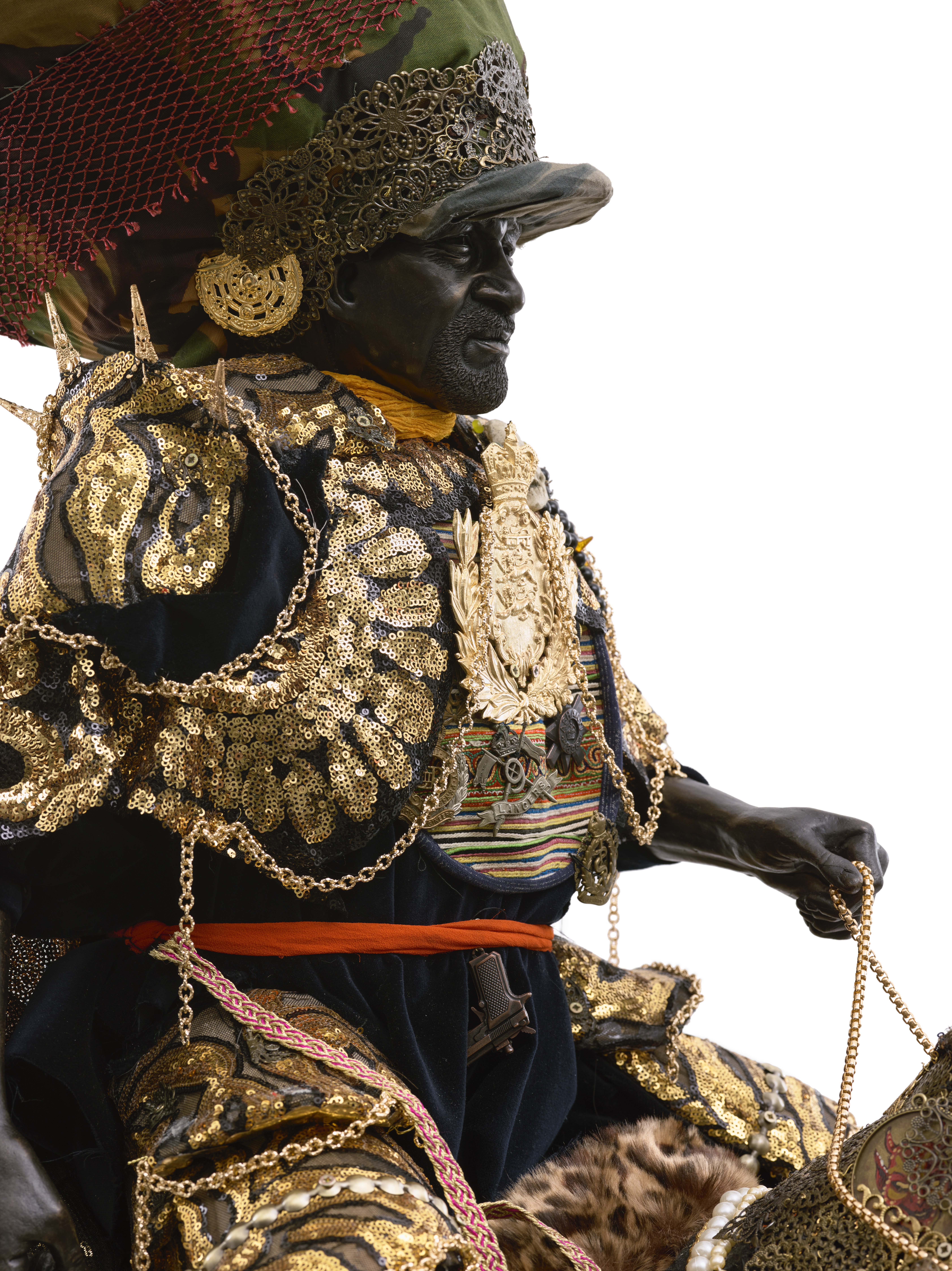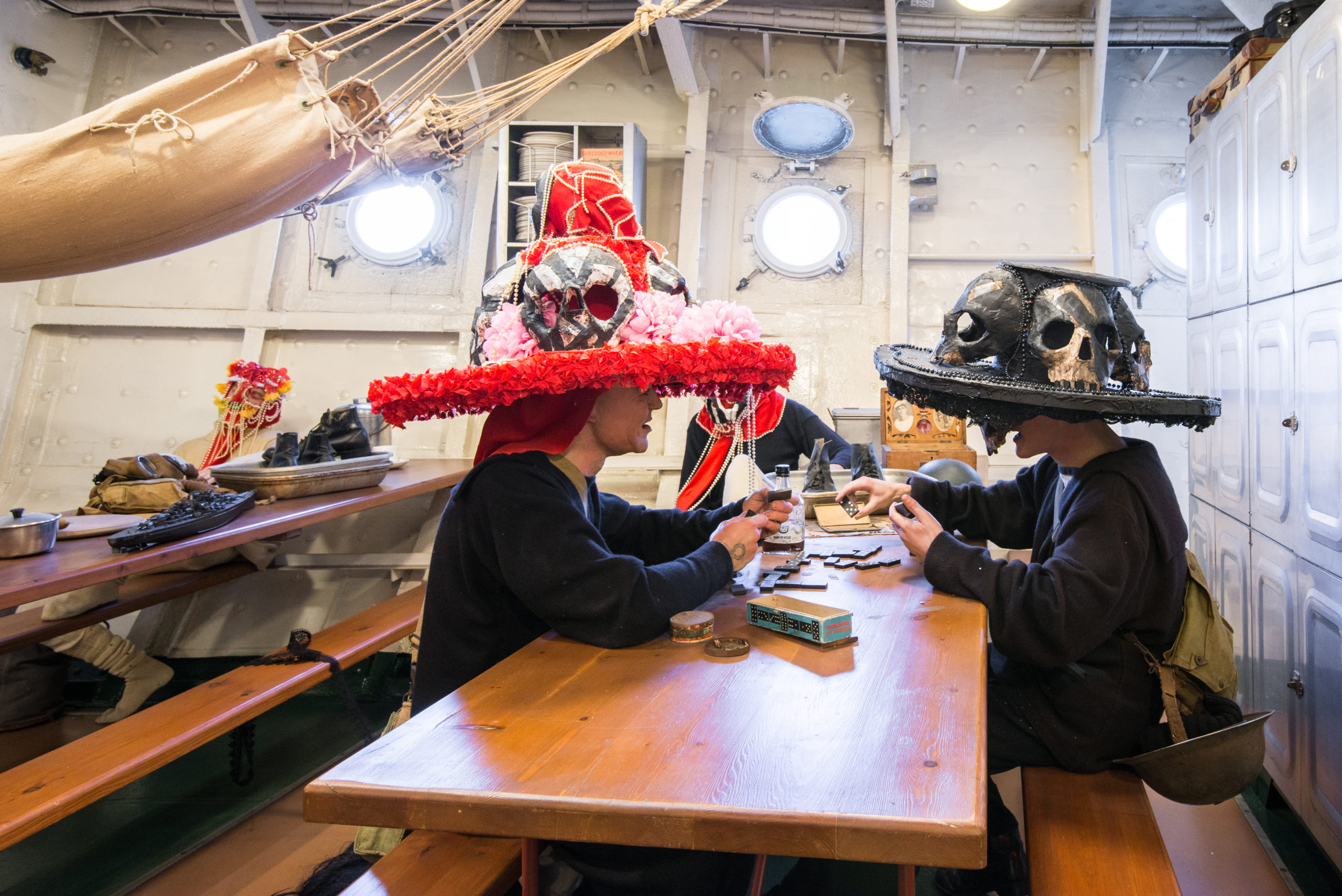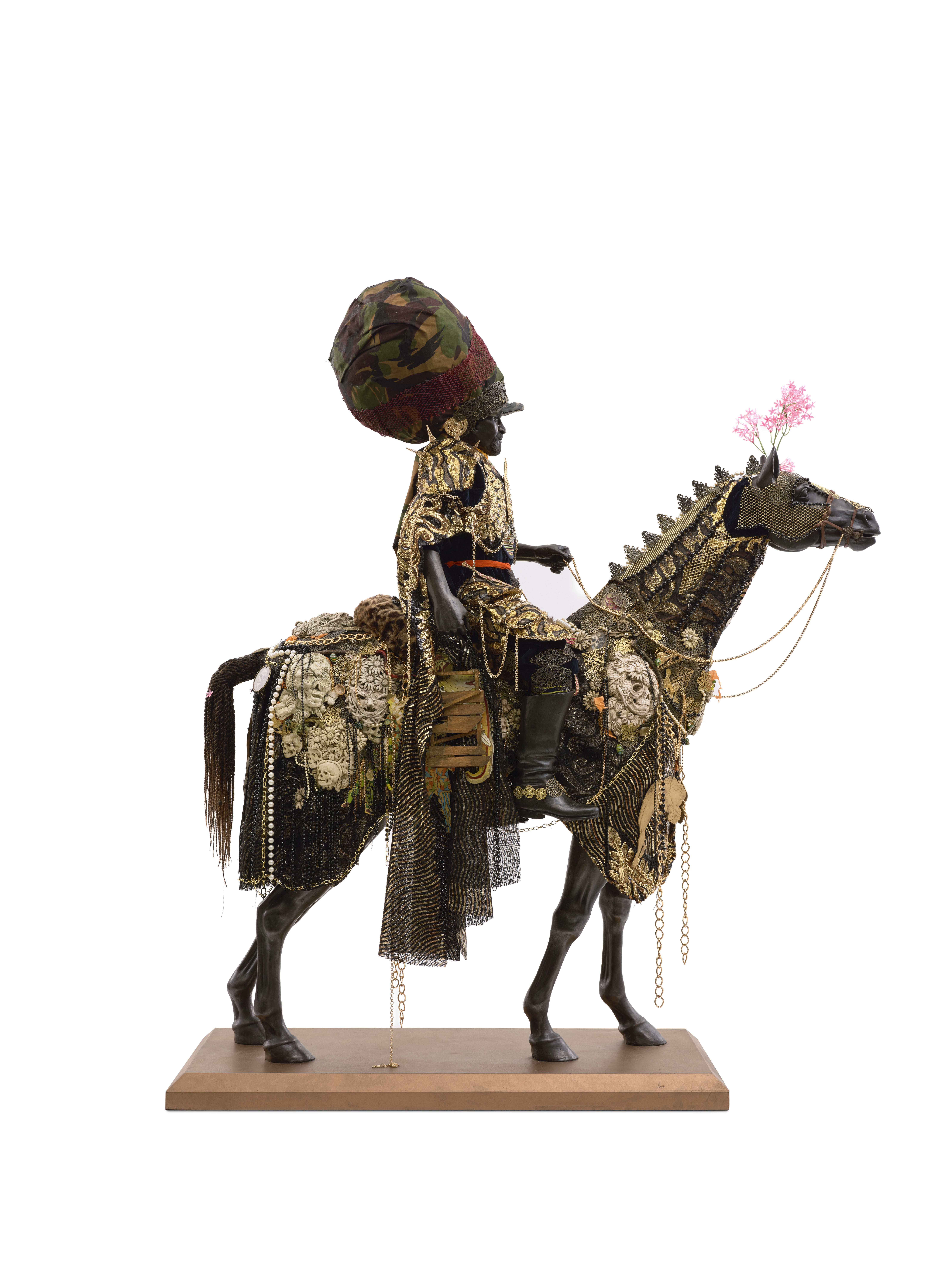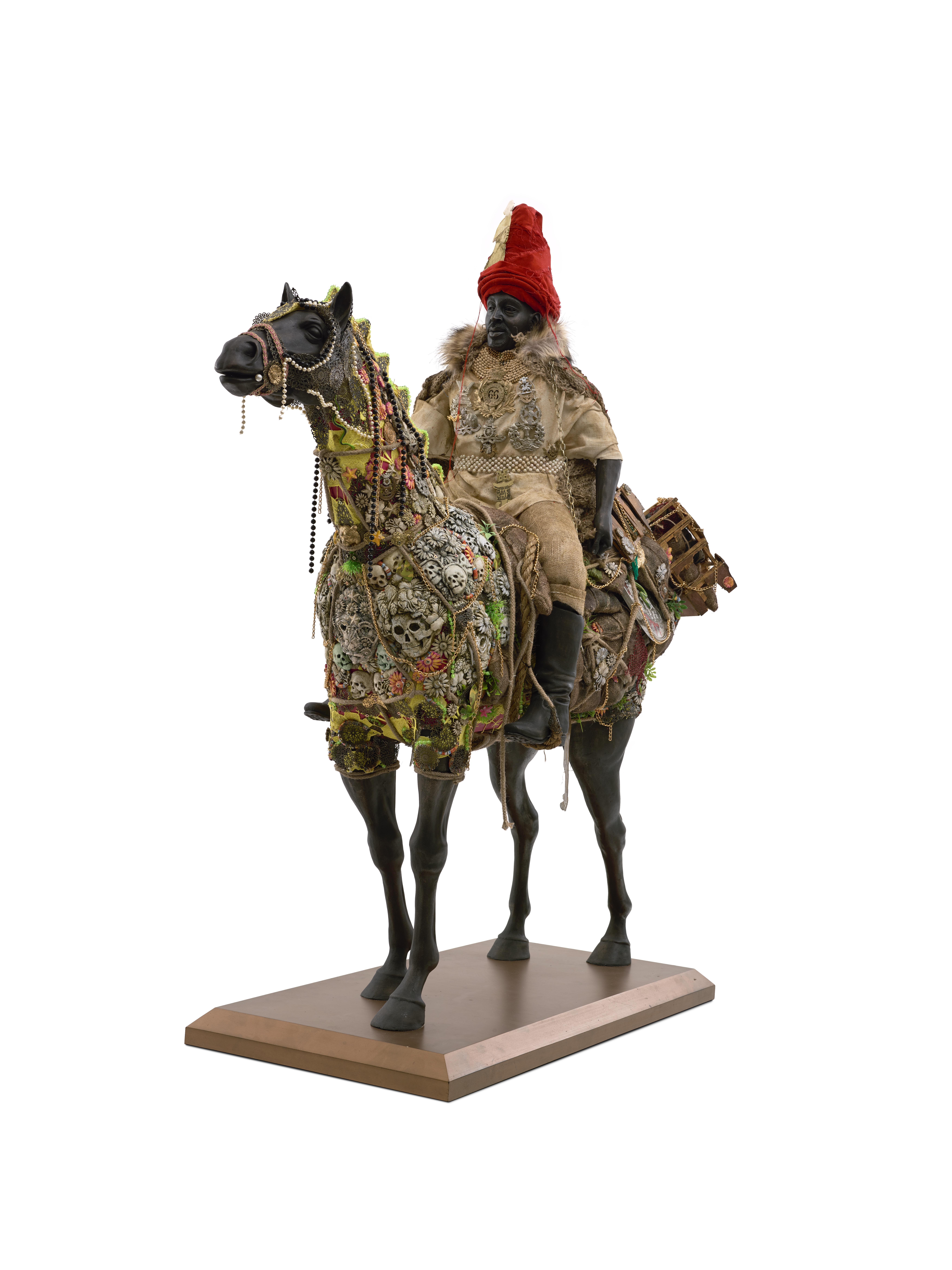Hew Locke: A World Before the World We Know
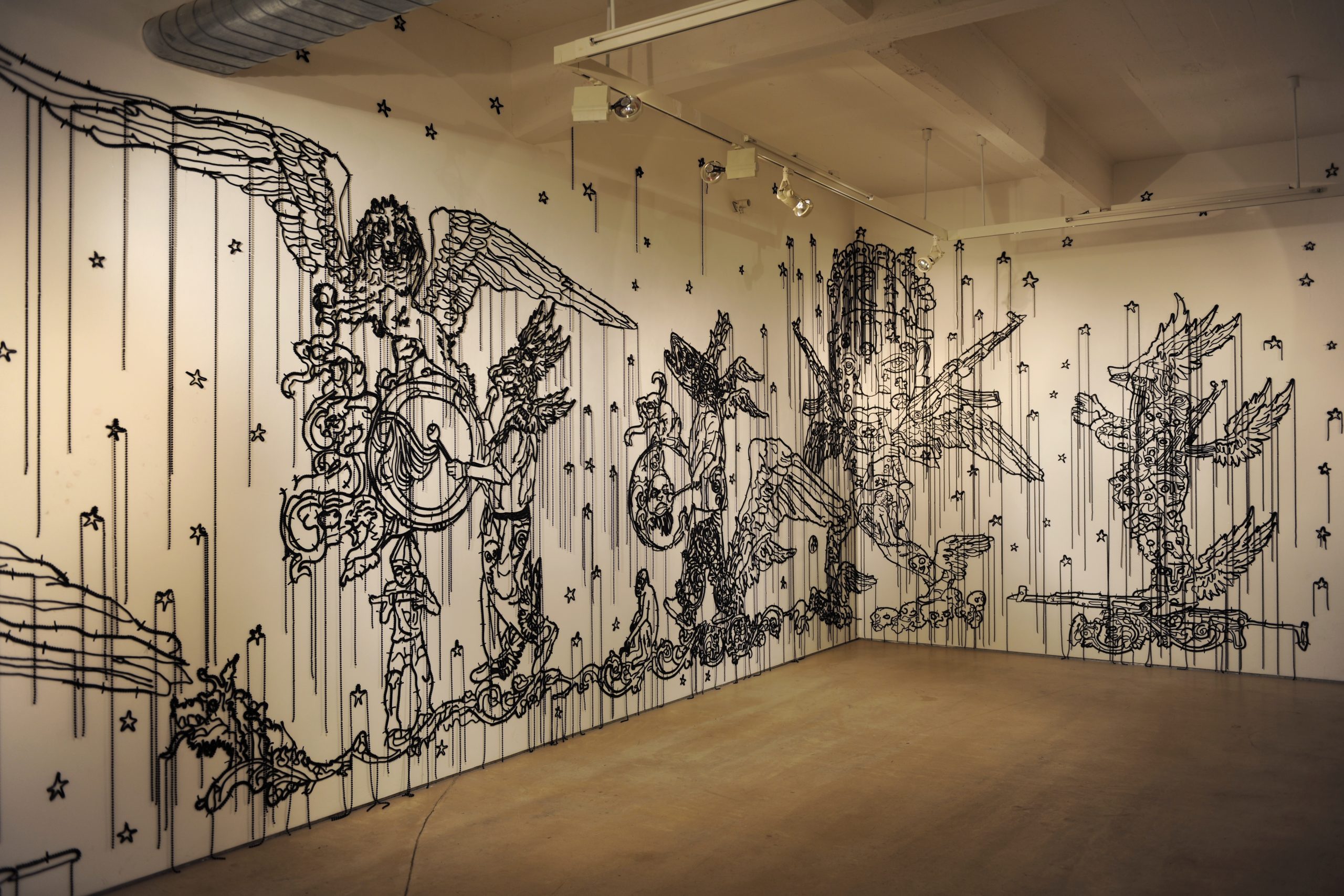
Hew Locke, The Nameless, installation detail, 2010 [Photo: Charles Littlewood; courtesy of the artist and Hales Gallery]
Share:
In the summer of 2019, Hew Locke and Indra Khanna, his wife, were my personal guides through the streets of Brixton. As we meandered the labyrinth of market stalls, we discussed a range of topics: migration, diaspora and community, gentrification, navigating the global art market, and the Caribbean. This outing came on the heels of Hew’s exhibition in Birmingham, England, in which such works as The Tourists (2015) and The Nameless (2010) were exhibited. The Tourists—presented as a haunting video installation—was an intervention that took place aboard the battlecruiser HMS Belfast, and that was commissioned by the Imperial War Museum, London. In many of his works, Locke evokes St. Lucian poet and Nobel Prize in Literature laureate Derek Walcott’s opening stanza of “The Sea Is History”:
Where are your monuments, your battles, martyrs?
Where is your tribal memory? Sirs,
in that grey vault. The sea. The sea
has locked them up. The sea is History.
This conversation is the first time we have spoken formally about his work.
Cosmo Whyte: I’ve been looking at your work for many years, but also reading your personal narrative of migration. I want to start off by talking about Guyana and the role that Guyana plays in the work.
Hew Locke: I think the important thing to know is that I arrived in Guyana at the time of Independence. I saw a nation coming into being. I remember being taken by my father to the [Government] Technical Institute, [as] I think it was called. On the back of the back wall, there was this design. It was designed for the new Guyana National Coat of Arms. I saw the flag. I knew how the flag was made. My mother—a White English woman marrying a Black Guyanese guy—she took on Guyana wholeheartedly. She made T-shirts with the Guyana flag on [them], printed them with linocuts. This was all so small-home enterprise—shirts with Guyana’s coat of arms on [them], because this thing was new and fresh, and it was memorable.
Hew Locke, Ambassador 1, 2021, resin, wood, metal, plastic, fabric, 59.06 x 59.06 x 23.62 inches [Photo: Anna Arca; courtesy of the artist]
CW: For me, within the work, there is always a return to Guyana in some way.
HL: Yes, it is always a return to Guyana. That is something I can say now. There was a time in my career when I had to hide this, I felt. Because, if you had mentioned Guyana, that was it. You were outside. You were deemed to be other. I’m talking about in the late 90s. This is before the world we know today, which is an international art world with international art fairs, and everybody’s excited to see what country is going to be the next important and hot thing. But back then, in the 90s, I had to hide the Guyana thing, because people didn’t get where I was coming from, basically.
CW: When you say “hide it,” are you talking about having it coded within the work?
HL: Coded, but also not mentioning Guyana at all. I stopped mentioning Guyana for about six, seven years, or something like that, you know? … What is interesting to me is the way the art world has changed. The work I do, where I am coming from, there is a definite place for it. But back in the 90s, [at] the height of the [Young British Artists] thing—[the art world] was a mix of that YBA thing and a much older, old-school, truth-to-materials kind of “manly arts.” The stuff I was doing would have been deemed decorative. That was a problem. A definite problem.
HL: But the work often comes back to Guyana. When I realized that even when I do something which is about this country, about the UK, about Britain, about London, about the makeup of British society, it still is about Guyana. The Guyana thing is in there somewhere. There’s something in there which …. You can’t get away from where you come from. I’m not sure if you want to.
HL: The interesting thing about it is that it can flip. When I’m in New York, when I’m in America, this British side comes out. I see things from a British point of view—also the Guyanese—but definitely from a British point of view, because of course, I am British, as well. So, there are two things which rise and surface at different points, depending on the circumstances that you’re in.
CW: Yeah, the fluidity of that perspective.
HL: Yeah, and it is how life is. It is a normal thing today, whereby you have somebody whose family has a background in, say, Bangladesh, or India, or Pakistan. That can be as important as their British identity. And it fluctuates, from time to time, in terms of what is more important.
CW: Right, yeah. Also, within the work: vessels, boats, ships figure quite prominently. I understand that when you migrated, when you left Guyana, you left by boat [and went] back to England.
HL: Yes. That was when I was young, when my dad was going to do a fellowship. I think it was a fellowship at Edinburgh College of Art. That was late 1970. After that, it was by charter plane—charter planes were how people went [later]. But back then, it was by boat. Going to Guyana as a kid—I think it would [have been] just before Guyana’s independence—that was by boat, as well. These things, when you are very young, they have a very powerful impact on you. Because they are showing you that this is a long journey, [and] it is not a cruise ship.
Hew Locke, The Tourists, installation detail, 2015 [Photo: Charles Littlewood; courtesy of the artist]
CW: That brings me to talk about some of your works [dealing] with the sea and these naval vessels. I’m particularly interested in talking about your presentation [On The Tethys Sea] at the Diaspora Pavilion in Venice in 2017, and The Tourists.
HL: The title is describing the world millions of years ago when the Tethys Sea was the first sea that came into being when Pangaea broke up. Bits of it remain as the Mediterranean. Land and sea bend around. The title is trying to talk to people in Europe, people in America, people all around, and trying to bend different migratory issues together. In America, migration is many things, obviously. It is a land of immigrants. I think of Haitians trying to get in by boat. I think of people trying to get across the border [from] Mexico. That is a different thing. Then, I think about the refugee crisis—which is ongoing—in the Mediterranean. More and more people, more recently, trying to get across the channel to the UK. Thousands of people, in this year, trying to get across.
HL: [The work] is about trying to make people think about situations beyond their personal experience. I am saying that there are other migrations going on, in other parts of the world. I’m even talking [about history], as far back as what we once called the “boat people,” [during the] Vietnamese refugee crisis. Now, that is part of history. The term Vietnamese American is [now] a normal thing, when once [they were referred to as] “boat people.” I am trying to make a complex kind of point, basically, on the international nature of migration and the history of migration, and the links between different countries, different sets of people trying to seek a new life for themselves. Because we all want to have a decent standard of living.
HL: They are all carefully worked-out miniature suspended boat sculptures, some found, which I re-work, and some made from scratch. They carry stories in them, but the stories are all miniaturized and condensed. What I found is that—for an audience, and for myself, as well—there is something very particular [to] how we feel about model boats. We feel very differently about model planes than [about] model boats, and boats in general. They are containers for our hopes. They hold life together. There is a reason why navy and naval [are etymologically linked] to the nave of a church. If you flip a church upside down, it can look like a boat. Moving on to The Tourists, that was a different thing.
Hew Locke, Ambassador 1, 2021, resin, wood, metal, plastic, fabric, 59.06 x 59.06 x 23.62 inches [Photo: Anna Arca; courtesy of the artist]
CW: You were actually on a boat.
HL: Yes. To explain, The Tourists is an installation that I did on HMS Belfast, back in 2015, a very strange environment. The Imperial War Museum came to me and asked me to do an installation onboard the boat, which I did. Later I made a film of the installation—also called The Tourists—which is a stand-alone piece of work. I should say, the HMS Belfast is an icon on the Thames—a warship moored in the centre of London—a museum ship. The piece was inspired by many things. HMS Belfast is a time capsule, kitted out as it was back in the 60s. You walk into the cabins and they are full of mannequins of sailors, but these [were] all sculpted in the 70s, so they look a bit strange. They are a bit unnerving, quite frankly.
HL: What I realized was that, to change the narrative of the museum display, all I had to do [was] put masks and costumes on these figures, and the narrative changes. The history is that HMS Belfast, in its last journey, came through the Caribbean, went to Jamaica, [at the time of] Jamaica’s independence, and came to Trinidad, I think, that August. So I created an alternative history, imagining these [sailors] arriving in February, in time for Carnival, and creating their own Mas band to join in. And what will they call their band? They are going to call it “The Tourists,” because they’re touring around the world. They are flying the flag for the British Empire—or the dwindling British Empire.
CW: I think that is the part that fascinates me: this idea that the boat is going to the Caribbean on the eve of independence, but trying to show naval power, as well. As a reminder, “You may be independent, but remember …”
HL: Exactly. They also were there at the independence of Tanzania. What I didn’t realize—well, I did realize that it was a serious thing I was attempting. But I just remembered, as I’m talking to you, that I signed an NDA, a nondisclosure agreement, so I can’t talk about what happened. But, long story short, the reaction was problematic, and the project was closed down half way through. I can’t really talk more about that.
CW: Understood, yes.
HL: Talk to some other people and you’ll get a different story—people who didn’t sign anything.
HL: But yeah, the idea was that there was music piping through the whole ship. Normally, it is a narrative of the sailors. I got them piping through Harry Belafonte, “Brown Skin Girl” [and] “Rum & Coca Cola” by Lord Invader. The whole idea behind this show is that these guys [the sailor mannequins] are dressing in costumes. I wasn’t making a joke about this thing at all. I was taking this whole process very, very seriously. These guys were living a life where they are bored, they are bored, they are bored—then it is intense excitement, fear, and adrenaline. These things are running side by side. The costumes, the whole thing, were about their inner dialogue, inner fears, their inner concerns.
CW: I find it fascinating, the idea of mapping this Caribbean expression, and everything that is encapsulated in Carnival, onto a symbol of empire.
HL: Exactly, exactly. There is a character from Trinidad Carnival I had never seen, but I am fascinated by—Midnight Robber. He wears a sombrero with skulls and stuff. I had a couple of these [mannequins] dressed in Midnight Robber headdresses. Then I had them painted with tattoos, but the old type of faded tattoo, which you will see old sailors having. The light-blue tattoos, not the fancy tattoos of today. It changed the narrative of the boat. And it worked. I thought it really, really worked. It was, to me, a very successful piece of work. Other people didn’t think so. But I thought it was really, really good.
CW: I thought it was quite successful. I remember seeing it in conjunction with The Nameless.
HL: Yeah, The Nameless is when I decided to relax. Nameless is a drawing made of bead and cord glue-gunned onto the wall. It is simple: You send somebody drawings and instructions, they project the image onto the wall, trace over in pencil, and then they work the image in beads and cord over that. What I love is being able to reveal the process. Viewers can see how it’s done. But still, it maintains its mystery. That, for me, is kind of important. But I first invented this technique back in Atlanta. I did a solo show in 2004 at Atlanta Contemporary. They had a touring show of mine coming from the Luckman Gallery, but they didn’t have the money to ship a big work from LA. As a result of that, I thought, My God, I’ve got a big wall to fill, and a big room to fill. How can I handle this?
Hew Locke, The Nameless, installation detail, 2010 [Photo: Charles Littlewood; courtesy of the artist and Hales Gallery]
HL: It’s the usual three-o’clock-in-the-morning thing, where I say, “I’ve got it!” Simple thing: a large wall drawing of a coat-of-arms in cord and beads. And it works, all these years later. Because [of] the experience of doing the show in Atlanta, I have Nameless. It is this endless procession of these figures. They are all chopped together / collaged together imagery, referring to colonialism and referring to many different things, but not [to any] literal narrative of, like, this is this. It was allowing myself to not have to be dictating things. Allowing myself to just reveal. Almost like automatic writing.
CW: Let’s talk about your new work. Is it The Ambassadors?
HL: The Ambassadors. I’m trying to think if I can talk. Let me ask Indra. I’ll consult my manager.
CW: Also tell Indra “Hi” for me, please.
[Locke leaves the room briefly, then returns.]
HL: Okay, no worries. Yeah, The Ambassadors. For years, I have been interested in statues. I’m still fascinated that this statue thing has become such a hot topic. The Ambassadors … it’s a statue represented in a different way. [The sculptures] are about a third of life size—or a third the size of a normal horse. [They are] equestrian statues, each different, about five and a half feet high, something like that. But intensely worked, almost like miniatures. The statues are based on the idea of dressing statues of Black people. It is difficult to explain.
CW: I’ve seen other works in which you have addressed the colonial histories of statues, and within the dressing of them, there are symbols that talk about the darker histories of these figures. Is that something similar? I mean, now the subjects are Black folks.
HL: Yes, this is imagining several different things. It is about statues, but then the horses and riders became real to me. They’re bronze equestrian figures of Black people. But they became something more than that: survivors, on horseback, in a dystopian, burnt-out landscape, heading to the future. What that future is, who knows? Carrying their history with them, that is what it becomes about. Within that context, they are carrying all kinds of colonial history. One figure [wears] a red turban. The central motif on his turban is a bust of Toussaint L’Ouverture. In his backpack is a massive badge taken from a medal of the Second Anglo-Afghan War, in the late 19th century. There are all these levels of history.
HL: The [term] people use for it is Afrofuturism, which is thrown around a lot. I wouldn’t make claims for this to be that, per se, but it is along that line. These [figures] are people who are burdened down. They come from somewhere, they come out of some empire, some imaginary place, some imaginary state. But at the same time, it is different because they are also statues. They are both statues of people, which have been decorated, and statues from some imaginary place, where there will be statues like that, and they’ll be decorated. They are also alive, real people who are on the move. It is two things. I’ll put it this way: I see two things when I look at them.
Hew Locke, Ambassador 2, 2021, resin, wood, metal, plastic, fabric, 59.06 x 59.06 x 27.56 inches [Photo: Anna Arca; courtesy of the artist]
CW: Got it. And the one after that, with the almost Rasta canopy hat. Can you tell me a little bit about that figure?
HL: I was wary of having him be a Rasta. I got complex feelings about that, but it seemed to work. Right at the bottom of his neck there is a skull, and below that there are two figures. Those figures are taken from an illustration, by [William] Blake, of a slave being tortured [during] a slave rebellion in Surinam. That [image] was used as a part of the Abolition campaign in Britain.
CW: My goodness.
HL: But the thing is, what I find [as I am] using these things is that if you paint them gold, then all of a sudden, they don’t [seem] horrible anymore. They become very reminiscent of attractive baroque carvings that you see in historic stately homes. There is something perverse about that because, of course, that world was supported by the slave trade and by the plantation system.
CW: We started off this conversation talking about Guyana, and you were talking about arriving at Guyana on the eve of Independence. As you’ve made this incredible body of work dealing with migration, with wayfinding, with this imagined cartography, in this post-Brexit, post–Windrush fiasco world, how has all this complicated your own feelings of Britishness?
HL: Well, my sense of Britishness is always complicated. Because I am British. When [I have been] asked, for [exhibition] catalogues, How do you want to be described? Do you want to be described as British Guyanese? British Guyanese [or] Guyanese British? To this day, that is where it gets interesting and complicated for me. I tend to go down the route of Guyanese British, even though it sounds convoluted. Because British Guyanese sounds like you are subject to the crown. Because that is what we were before Independence. British is negating the Guyana factor, you know? There was a time when I had to say just “British” alone, because otherwise you were not accepted in the art world. It is not about wanting to be accepted, it is about not wanting to be shut out.
Cosmo Whyte was born in Jamaica and has exhibited his works there, as well as in the United States, The Netherlands, Norway, England, France, and South Africa. Whyte has been the recipient of the Harpo Award (2021), a fellowship from Art Matters (2019) and Biennial Competition Award from the Louis Comfort Tiffany Foundation (2019), the MOCA GA Working Artist Project Award (2018), The Drawing Center’s Open Sessions fellowship (2018), Artadia Award (2016), the International Sculpture Center’s Outstanding Student Achievement in Contemporary Sculpture Award (2015), and the Forward Arts Foundation Emerging Artist Award (2010). Whyte attended Bennington College in Vermont for his BFA, Maryland Institute College of Art for a Postbaccalaureate Certificate, and the University of Michigan for his MFA.
